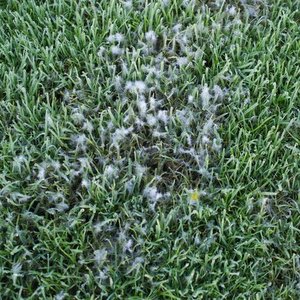

These hyphae release hydrolytic enzymes to destroy the root tissue and absorb nutrients as a food source. Zoospores that reach the plant root surface encyst, germinate and colonize the root tissue by producing fine thread-like structures of hyphae, collectively called mycelium. Pythium spreads by forming sporangia, sack-like structures, each releasing hundreds of swimming zoospores (Figure 1). Greenhouse insects such as fungus gnats (Bradysia impatiens) and shore flies (Scatella stagnalis) can also carry Pythium. Pythium can be introduced into a greenhouse in plug transplants, soil, growing media, plant refuse and irrigation water. The grass leaves take on a dark green, water-soaked appearance and cottony mycelium may be present on the blades of grass. The blight begins as small (six inch), circular, reddish brown spots that begin to coalesce. The grasses usually die and are slow to recover. Pythium blight is an aggressive disease of turf grasses. The symptoms and extent of damage caused depend on the region infected. Pythium sp infects seeds, juvenile tissue, lower stems, fruit rot and roots. Plants grown under optimal environmental conditions are less susceptible to Pythium than plants grown under poor conditions. Saturated growing media that are either too cold or too warm can be conducive to Pythium build up and spread in water and recirculating nutrient solution. Over watering, poor root aeration, root injury and improper root zone temperatures can weaken the crop and, thus, trigger Pythium outbreaks. There are no Pythium resistant varieties available although some varieties may have disease tolerance. ultimum, are known to cause damping-off and crown and root rot in greenhouse cucumber, pepper and tomato crops. In Canada, several Pythium species, including P. Pythium infection leads to damping off in seedlings and crown and root rot of mature plants. While Pythium root rot is caused by several different species of Pythium with different temperature optima cool to hot, Phytophthora blight is only favored by hot weather.

Some Pythium species can cause serious diseases on greenhouse vegetable crops resulting in significant crop losses. Heavy rains early in the planting season favor both Pythium root rot and Phytophthora blight.

If extensive damage appears, turf seldom responds to fungicide treatment (See the section Chemical Controls for Turfgrass Diseases).Pythium species are fungal-like organisms (Oomycetes), commonly referred to as water molds, which naturally exist in soil and water as saprophytes, feeding on organic matter. Fungicide control of Pythium root rot is less consistent than control of foliar blight. During extended periods of warm, humid weather, a preventive fungicide program is advised. Increasing the mowing height and other practices that promote root growth may lessen the damage from Pythium root rot. Increase air movement by reducing shading, selective pruning or fans. Remove thatch with frequent verticutting and avoid overfertilization. Avoid late day watering and overwatering new plantings. Symptoms of Pythium root rot mimic melting out and anthracnose and there is no foliar mycelium.Ĭontrol and Management: Diagnosis should be confirmed by a diagnostic laboratory as soon as possible. It also can cause crown and root rots which generally occur in early spring or late fall when soils are cool and excessively wet or saturated. Pythium may cause seedling blight and poor stand development in perennial ryegrass overseedings. Hybrid bermudas are more susceptible to pythium than common bermudagrass. When disease is very active, fungal mycelium grows profusely over affected plants so that diseased areas have a cotton-like appearance. On close-cut turf, pythium blight may appear as streaks that follow water drainage or mowing patterns. Roundish, dark, greasy to slimy patches of matted grass, from two to 12 inches in diameter, appear suddenly.
PYTHIUM BLIGHT SERIES
Host Grass: Hybrid Bermuda( Cynodon dactylon), Common Bermuda, Bentgrass( Agrostis palustris), Fescue, Perennial Ryegrass (Lolium perenne), Poa Series (Poa sp.)Ĭause and Sym p toms: Disease is favored during rainy, foggy weather and in low lying areas where air circulation is poor. Pythium Blight, Cottony Blight, Greasy Spot (fungus – Pythium aphanidermatum )


 0 kommentar(er)
0 kommentar(er)
